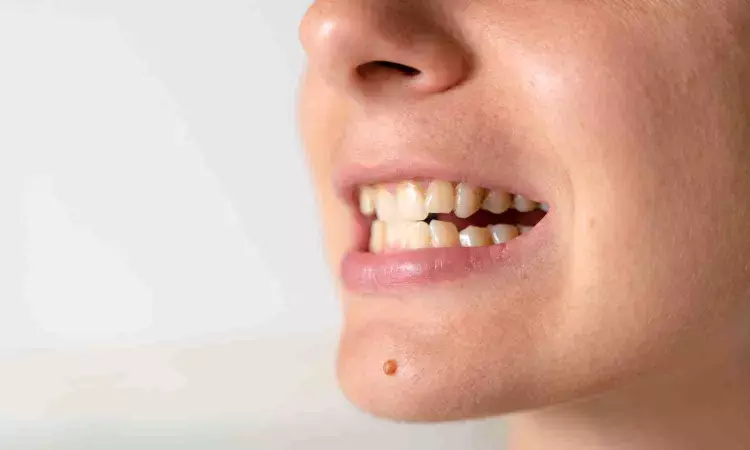- Home
- Medical news & Guidelines
- Anesthesiology
- Cardiology and CTVS
- Critical Care
- Dentistry
- Dermatology
- Diabetes and Endocrinology
- ENT
- Gastroenterology
- Medicine
- Nephrology
- Neurology
- Obstretics-Gynaecology
- Oncology
- Ophthalmology
- Orthopaedics
- Pediatrics-Neonatology
- Psychiatry
- Pulmonology
- Radiology
- Surgery
- Urology
- Laboratory Medicine
- Diet
- Nursing
- Paramedical
- Physiotherapy
- Health news
- Fact Check
- Bone Health Fact Check
- Brain Health Fact Check
- Cancer Related Fact Check
- Child Care Fact Check
- Dental and oral health fact check
- Diabetes and metabolic health fact check
- Diet and Nutrition Fact Check
- Eye and ENT Care Fact Check
- Fitness fact check
- Gut health fact check
- Heart health fact check
- Kidney health fact check
- Medical education fact check
- Men's health fact check
- Respiratory fact check
- Skin and hair care fact check
- Vaccine and Immunization fact check
- Women's health fact check
- AYUSH
- State News
- Andaman and Nicobar Islands
- Andhra Pradesh
- Arunachal Pradesh
- Assam
- Bihar
- Chandigarh
- Chattisgarh
- Dadra and Nagar Haveli
- Daman and Diu
- Delhi
- Goa
- Gujarat
- Haryana
- Himachal Pradesh
- Jammu & Kashmir
- Jharkhand
- Karnataka
- Kerala
- Ladakh
- Lakshadweep
- Madhya Pradesh
- Maharashtra
- Manipur
- Meghalaya
- Mizoram
- Nagaland
- Odisha
- Puducherry
- Punjab
- Rajasthan
- Sikkim
- Tamil Nadu
- Telangana
- Tripura
- Uttar Pradesh
- Uttrakhand
- West Bengal
- Medical Education
- Industry
Long term Profile attractiveness similar in extraction and nonextraction groups among patients with class I and II malocclusion: Study

Long term Profile attractiveness similar in extraction and nonextraction groups among patients with class I and II malocclusion suggests a study published in the American Journal of Orthodontics and Dentofacial Orthopedics.
The objective of this study was to compare the profile attractiveness in subjects treated with and without extractions after the long-term 35-year follow-up, according to laypeople, dentists, and orthodontists. A total of 40 patients with Class I and II malocclusion were divided into 2 groups, according to the treatment protocol: extraction (E) group, extractions of 4 premolars (n = 24), with mean pretreatment (T1), posttreatment (T2), and long-term posttreatment (T3) ages of 13.13, 15.50 and 49.56 years, respectively. The mean treatment time (T2 - T1) was 2.37 years, and the long-term follow-up (T3 - T2) was 34.19. Nonextraction (NE) group (n = 16), with mean ages at T1, T2, and T3 of 13.21, 15.07, and 50.32 years, respectively.
The mean (T2 - T1) was 1.86 years, and the (T3 - T2) was 35.25 years. Lateral cephalograms were used to perform profile facial silhouettes, and an online evaluation was performed by 72 laypeople, 63 dentists, and 65 orthodontists, rating the attractiveness from 1 (least attractive) to 10 (most attractive). The intragroup comparison was performed with the repeated measures analysis of variance and Tukey tests. Intergroup comparison was performed with t tests, 1-way analysis of variance, and Tukey tests. Results: The E group had a longer treatment time than that of the NE group. In the pretreatment, posttreatment, and long-term posttreatment stages, the E and NE groups showed similar profile attractiveness. Laypersons and dentists were more critical than orthodontists. At long-term posttreatment follow-up, profile attractiveness was similar in patients treated with and without extractions.
Reference:
Bravo Vallejo G, Alcaraz Ros GD, Peloso RM, Gambardela-Tkacz CM, Cotrin P, Freitas KMS, de Freitas MR. Long-term profile attractiveness of patients with Class I and II malocclusion treated with and without extractions: A 35-year follow-up. Am J Orthod Dentofacial Orthop. 2024 Jan 16:S0889-5406(23)00661-3. doi: 10.1016/j.ajodo.2023.11.009. Epub ahead of print. PMID: 38231168.
Dr. Shravani Dali has completed her BDS from Pravara institute of medical sciences, loni. Following which she extensively worked in the healthcare sector for 2+ years. She has been actively involved in writing blogs in field of health and wellness. Currently she is pursuing her Masters of public health-health administration from Tata institute of social sciences. She can be contacted at editorial@medicaldialogues.in.
Dr Kamal Kant Kohli-MBBS, DTCD- a chest specialist with more than 30 years of practice and a flair for writing clinical articles, Dr Kamal Kant Kohli joined Medical Dialogues as a Chief Editor of Medical News. Besides writing articles, as an editor, he proofreads and verifies all the medical content published on Medical Dialogues including those coming from journals, studies,medical conferences,guidelines etc. Email: drkohli@medicaldialogues.in. Contact no. 011-43720751


